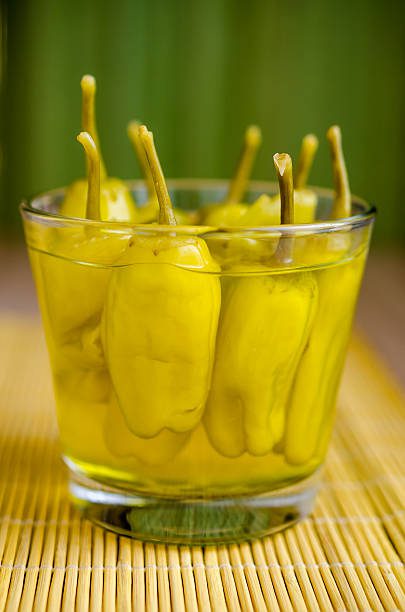Pepperoncini peppers are a popular Italian variety of chilli peppers that are commonly used in Mediterranean cuisine. These peppers are small and tapered, with a slightly wrinkled appearance, and are typically yellow or green. They are often pickled and served as a condiment, but can also be used fresh in salads, sandwiches, and other dishes.
Pepperoncini peppers are known for their mild heat, which ranges from 100 to 500 Scoville units. This makes them much milder than other popular chilli peppers, such as jalapeños and habaneros. Despite their mildness, pepperoncini peppers still pack a flavorful punch, with a slightly sweet and tangy taste that pairs well with a variety of foods.
In addition to their culinary uses, pepperoncini peppers are also believed to have health benefits. They are a good source of vitamin C, which is important for immune system function, and also contain antioxidants that may help protect against disease. Overall, pepperoncini peppers are a versatile and tasty ingredient that can add a unique flavour and nutritional boost to any dish.
Origins of Pepperoncini Peppers
Pepperoncini peppers are a popular type of chilli pepper that originated in Italy. The pepperoncini pepper is also known as the Tuscan pepper, sweet Italian pepper, and golden Greek pepper. The pepperoncini pepper is a member of the Capsicum annuum species, which includes other popular chilli peppers such as jalapeños, bell peppers, and cayenne peppers.
The pepperoncini pepper is believed to have originated in the Tuscan region of Italy and has been a staple in Italian cuisine for centuries. The pepperoncini pepper is also commonly used in Greek, Turkish, and Balkan cuisine.
Pepperoncini peppers are typically harvested when they are still green, but can also be harvested when they turn red. The peppers are often pickled in vinegar and used as a condiment or added to salads and sandwiches for a tangy and slightly spicy flavour.
Today, pepperoncini peppers are grown in many countries around the world, including the United States, Mexico, and Spain. The pepperoncini pepper is a versatile ingredient that can be used in a variety of dishes, from pizzas and pasta to soups and stews.
Cultivation and Growth
Ideal Conditions
Pepperoncini peppers thrive in warm and sunny environments. They require a minimum of six hours of sunlight per day and grow best in well-drained soil with a pH between 6.0 and 7.0. These peppers can be grown in both containers and in-ground gardens.
Planting Process
Pepperoncini peppers should be planted in the spring after the last frost. The seeds should be sown 1/4 inch deep and spaced 18-24 inches apart. Once the seedlings reach a height of 3 inches, thin them out so that they are 12-18 inches apart. This will allow for proper air circulation and prevent disease.
Harvesting Time
Pepperoncini peppers are ready to be harvested when they reach a length of 3-4 inches and have turned a bright yellow-green colour. The peppers should be picked frequently to encourage further growth. It is important to wear gloves when harvesting as the oils from the peppers can irritate the skin.
In summary, pepperoncini peppers require warm and sunny conditions, well-drained soil, and proper spacing. They should be planted in the spring and harvested when they reach a length of 3-4 inches. With proper care, these peppers can be a delicious addition to any garden.
Nutritional Profile
Pepperoncini peppers are a low-calorie food that provides several essential nutrients. A single pepperoncini pepper contains approximately 4 calories, making it a great addition to any diet.
Pepperoncini peppers are an excellent source of vitamin C, providing 15% of the daily recommended intake per pepper. Vitamin C is an essential nutrient that helps support a healthy immune system and aids in the absorption of iron from plant-based foods.
In addition to vitamin C, pepperoncini peppers are also a good source of vitamin A, providing 6% of the daily recommended intake per pepper. Vitamin A is important for maintaining healthy vision, skin, and immune function.
Pepperoncini peppers are also a good source of fibre, with each pepper providing approximately 1 gram of fibre. Fiber is essential for maintaining digestive health and promoting feelings of fullness, which can aid in weight management.
Overall, pepperoncini peppers are a nutritious addition to any diet, providing several essential vitamins and minerals in a low-calorie package.
Culinary Uses
Pepperoncini peppers are a versatile ingredient that can be used in a variety of culinary applications. Here are some of the most common ways to use them:
Pickling
Pepperoncini peppers are often pickled and used as a condiment or topping for sandwiches and salads. To pickle pepperoncini peppers, they are typically packed in vinegar and salt brine along with other flavourings like garlic, dill, and mustard seeds. The pickling process gives the peppers a tangy, slightly sweet flavour that pairs well with a variety of foods.
Salads
Pepperoncini peppers are a popular addition to salads, particularly Greek salads. They add a tangy, slightly spicy flavour that complements the other ingredients in the salad. To use pepperoncini peppers in a salad, simply slice them into rings and toss them with the other ingredients.
Pizza Toppings
Pepperoncini peppers can also be used as a pizza topping, either on their own or in combination with other toppings like sausage, mushrooms, and onions. The peppers add a tangy, slightly spicy flavour to the pizza that pairs well with the cheese and other toppings.
Overall, pepperoncini peppers are a versatile ingredient that can be used in a variety of culinary applications. Whether you’re pickling them, using them in salads, or topping your pizza with them, they add a unique flavour and texture that can take your dishes to the next level.
Health Benefits
Pepperoncini peppers are not only delicious but also packed with nutrients that provide several health benefits. Here are some of the benefits of consuming pepperoncini peppers:
Rich in Vitamins and Minerals
Pepperoncini peppers are an excellent source of vitamins and minerals. They are rich in vitamin C, which helps boost the immune system and supports the growth and repair of tissues in the body. They also contain vitamin A, which is essential for healthy eyesight and skin. Additionally, pepperoncini peppers contain calcium, potassium, and iron, which are vital for maintaining healthy bones, muscles, and blood pressure.
Anti-Inflammatory Properties
Pepperoncini peppers contain capsaicin, which is a natural anti-inflammatory compound. Capsaicin has been found to reduce inflammation in the body, which is linked to several chronic diseases such as cancer, arthritis, and heart disease. Consuming pepperoncini peppers regularly may help reduce the risk of developing these diseases.
Aid in Digestion
Pepperoncini peppers are a good source of fibre, which is essential for maintaining a healthy digestive system. Fiber helps regulate bowel movements, prevents constipation, and reduces the risk of developing digestive disorders such as irritable bowel syndrome (IBS) and colon cancer.
Low in Calories
Pepperoncini peppers are low in calories, making them an excellent snack option for those looking to lose weight or maintain a healthy weight. One pepperoncino pepper contains only 4-5 calories, making it a guilt-free snack option.
In conclusion, pepperoncini peppers are a delicious and healthy addition to any diet. They are rich in vitamins and minerals, have anti-inflammatory properties, aid in digestion, and are low in calories. Incorporating pepperoncini peppers into your diet may provide several health benefits.
Potential Risks
Pepperoncini peppers are generally considered safe for consumption, but there are a few potential risks to be aware of.
Allergic Reactions
Like any food, pepperoncini peppers can cause allergic reactions in some people. Symptoms of an allergic reaction may include hives, swelling, difficulty breathing, or anaphylaxis. People with a known allergy to other types of peppers or nightshade plants should exercise caution when consuming pepperoncini peppers.
Capsaicin Sensitivity
Pepperoncini peppers contain capsaicin, the compound responsible for their spicy flavour. Some people may be more sensitive to capsaicin than others and may experience discomfort or pain when consuming pepperoncini peppers. Symptoms of capsaicin sensitivity may include burning or stinging sensations in the mouth, throat, or digestive tract.
Contamination
As with any fresh produce, there is a risk of contamination with harmful bacteria such as E. coli or Salmonella. To reduce the risk of contamination, it is important to wash pepperoncini peppers thoroughly before consuming them. People with weakened immune systems, such as the elderly or young children, should be especially cautious and avoid consuming raw pepperoncini peppers.
Overall, pepperoncini peppers are a safe and healthy addition to most diets, but it is important to be aware of the potential risks and exercise caution when consuming them.
Comparison with Similar Peppers
Banana Peppers
Pepperoncini peppers are often compared to banana peppers due to their similar appearance and taste. However, there are some differences between the two.
- Heat level: Pepperoncini peppers are slightly hotter than banana peppers. Pepperoncini peppers have a Scoville rating of 100-500, while banana peppers have a Scoville rating of 0-500.
- Size and shape: Pepperoncini peppers are smaller and slimmer than banana peppers, which are longer and thicker.
- Flavour: Both peppers have a mild, sweet taste, but pepperoncini peppers have a slightly tangier flavour.
Jalapeno Peppers
Jalapeno peppers are another popular type of pepper that is often compared to pepperoncini peppers. Here are some differences between the two:
- Heat level: Jalapeno peppers are significantly hotter than pepperoncini peppers. Jalapeno peppers have a Scoville rating of 2,500-8,000, while pepperoncini peppers have a Scoville rating of 100-500.
- Size and shape: Jalapeno peppers are larger and thicker than pepperoncini peppers, which are smaller and slimmer.
- Flavour: Jalapeno peppers have a distinct flavour that is spicier and more savoury than pepperoncini peppers. Pepperoncini peppers have a mild, sweet flavour with a slight tanginess.
In summary, while pepperoncini peppers may have some similarities with banana peppers and jalapeno peppers, they differ in terms of heat level, size and shape, and flavour.
Related

